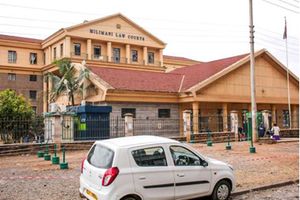Premium
Kenya less dark but road humps more

Long distance trucks at Kaburengu Interchange on the Eldoret-Webuye highway, join the long queue from Malaba border before proceeding to Uganda, stretching 67 kilometres on January 14, 2022.
What you need to know:
- I was struck that the Kenya of today is far less dark than the one you will have encountered even just five years ago.
- The fellow who lives five hills away, and might not travel on the road for months, sees the bright lights far away.
Barring a quick trip to Naivasha late last year, over this Covid-19 period I didn’t travel outside Nairobi by road and, therefore, didn’t encounter “Kenya out there” much.
Double-vaccinated, boosted and trying to shake off cabin fever, I ventured far a few days ago, driving from Nairobi to Uganda via Malaba. Most of it was a night drive — and it seems the gods of journalism conspired to make it so.
I was struck that the Kenya of today is far less dark than the one you will have encountered even just five years ago, all thanks to county politics and the solar streetlights. Fellows in Kenya are eating public money left and right, with President Uhuru Kenyatta saying not too long ago that Sh2 billion is stolen every day.
There has also been a counter and growing virulent grassroots opposition over corruption, which could be electorally costly for many. County governments are, therefore, keen to show that they are investing in development and to put it where the most people can see it. With their ever-falling price and relatively low cost of maintenance, solar streetlights have become their favourite platform.
All who drive by can testify to the lights and even, like this columnist, write or tweet about them. Lights also have one advantage over a road. The fellow who lives five hills away, and might not travel on the road for months, sees the bright lights far away. Even though they aren’t shining on his courtyard, they will still make a statement about progress and possibility. At this rate, it could be possible to drive along a largely lit route from Nairobi to Malaba or Busia in another eight years.
The lights, however, don’t mean the corrupt will have nowhere left to hide.
Several road humps
After some unfriendly contacts with mole hill-sized road humps on Kenya’s stretch of the Northern Corridor, as I drove into my little hometown at the ungodly hour of 3am, I had a eureka moment. Kenya and Uganda, we have observed before, are uncannily similar countries. I realised that they are also united by their love of road humps.
On a stretch of about two kilometres on a once-beautiful sandy murram road, I was confronted by four mean road humps. Between Nairobi and Malaba, there are probably over 50 of them. And the Kenyan ones get bigger every year. The way things are going, Kenya could have three-foot-tall road humps by 2025.
Pre-Covid, I was struck that a drive through both rural Kenya and Uganda was marked by several road humps. It seems a village chief is no longer worth any salt if he or she doesn’t plant at least five humps through the road — or even path — going through their village.
The best that can be said about this is that it is a battle by states bedevilled by a credibility problem, against the most unruly and law-breaking citizens in the region. We are yet to look at the numbers from other African countries, but it wouldn’t be surprising if Kenya and Uganda had the most road humps per capita in Africa.
And the Kenyan roadblock, too, is back in full blast. A while back, in another drive across Kenya, after we passed a police roadblock, and I complained that there had been too many, my astute driver told me our lives were about to get better.
Police roadblocks
We were headed into poorer parts of Kenya with no farmers transporting cattle, huge lorries of food destined for markets and no trucks transporting goods to neighbouring countries. And so it was. The lone roadblock we ran into waved us quickly through in irritation; they could see from a mile away that we had nothing of value they could shake us down over.
Counties like Nairobi, Kiambu, Nakuru, and Uasin Gishu are roadblock heaven. If you can plot the number of roadblocks and the contingent of police officers manning them, you would get a fairly good map of the concentration of wealth in Kenya.
None of that trumps the big shocker. From just before Sango, Webuye, a queue of trucks stretched up to the Malaba border. In all, it was about 70 kilometres long. It was beyond belief and even dizzying driving along the queue. It’s the consequence of a truck pile-up from the controversy over Uganda’s decision to demand $30 (Sh3,000) Covid-19 tests at the border for truckers. Kenya requires only a PCR-negative certificate.
Although the fees have been revised, the requirement of the test hasn’t. The result is that fuel prices at some Ugandan pumps have shot up nearly 200 per cent, to the equivalent of Sh310 a litre. The biggest casualties in Kenya could be the shops and supermarkets along the highway.
The trucks have choked off all their transit customers because there’s simply no way to stop and get out. As a driver, if you get into the crazy single queue, you can’t take a bathroom break for hours. Don’t forget an empty water bottle if you are heading those ends.
Mr Onyango-Obbo is a journalist, writer and curator of the Wall of Great Africans. @cobbo3





